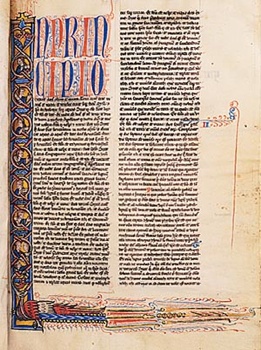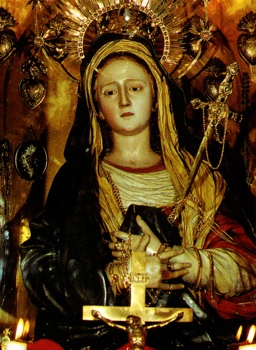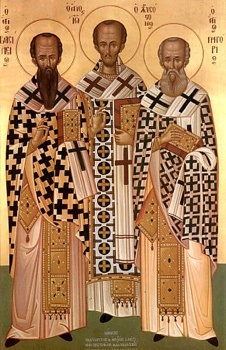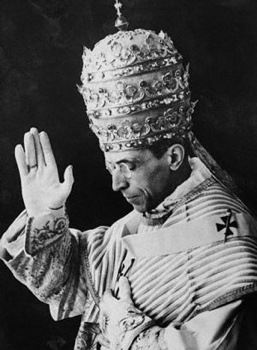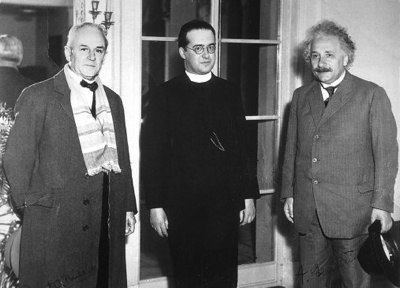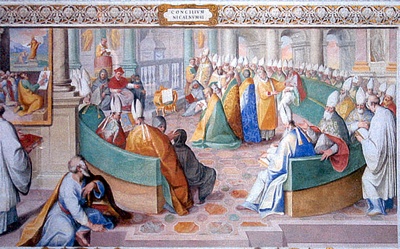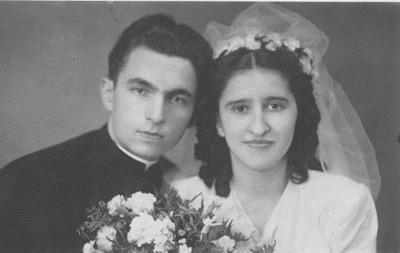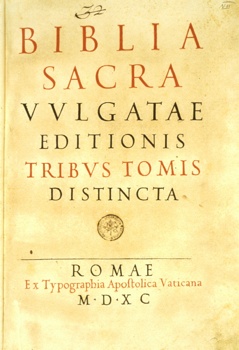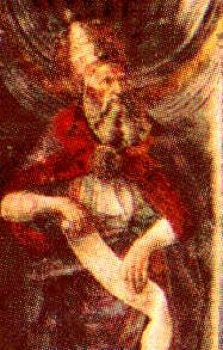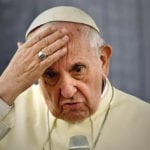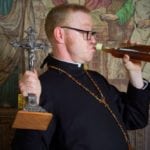Misconception: The Church discourages Bible reading The very first Christian Bible was produced by the Catholic Church – compiled by Catholic scholars of the 2nd and 3rd century and approved for general Christian use by the Catholic Councils of Hippo (393) and Carthage (397). The very first printed Bible was produced under the auspices of the Catholic Church – printed by the Catholic inventor of the printing press, Johannes Gutenberg. And the very first Bible with chapters and numbered verses was produced by the Catholic Church–the work of Stephen Langton, Cardinal Archbishop of Canterbury. At every Mass in the world everyday, the Bible is read aloud by the priest. In the traditional Mass there is one reading from the general body of the Bible (excluding the gospels), and two from the Gospels. In the modern Catholic Mass, there are two readings from the general body of the Bible and one from the Gospels. All Catholic homes have a Bible and the Bible is taught in Catholic schools (as is its perennial tradition). This myth has come about because Bibles were often locked away in Churches in the past, but that was not to prevent people having access – it was to prevent them being stolen. These were hand written Bibles which were incredibly valuable due to scarcity. Furthermore, people think the Church forbade people from reading the Bible by putting it on the Index of Forbidden Books, but the Bibles placed on the Index were Protestant versions (lacking 7 books) or badly translated versions – the most famous of which is the King James Version which Catholics are not supposed to use.
Misconception: Catholics worship Mary and are, therefore, committing idolatry In Catholic theology there are three types of worship – one of which is condemned in the Bible if offered to anyone but God:
- Latria – this is adoration which is given to God alone – giving this type of worship to anyone else is considered to be a mortal sin and it is the idolatry condemned in the Bible.
- Hyperdulia – this is a special type of worship given to Mary the Mother of Jesus – it is only given to her and it is not considered to be idolatory as it is not adoration, merely reverence.
- Dulia – this is the special type of worship given only to the saints and angels – it is also not idolatrous as it, too, is a form of reverence. The distinction was made by the 2nd Council of Nicaea in 787 AD. The council was called to condemn the people who claimed that it was idolatrous to have statues and images of saints. The canons of the Council can be read here. Just to clarify: “Latria is a Latin term (from the Greek ???????) used in Orthodox and Catholic theology to mean adoration, which is the highest form of worship or reverence and is directed only to the Holy Trinity.” – there are lower forms of worship (as is implied here). A Catholic who may kneel in front of a statue while praying isn’t worshipping the statue or even praying to it, any more than the Protestant who kneels with a Bible in his hands when praying is worshipping the Bible or praying to it. The images of saints (whether it be in statue form or painting) serves as a reminder of the holiness of the person depicted.
Misconception: Catholics aren’t Christians In fact, Catholics are the first Christians. When reading over the early Christian writings, you can see clearly that their doctrines and teachings are the same as the Catholic Church today. You hear of Bishops, virgins living in community (nuns), priests, confession, baptism of infants, the Bishop of Rome as head of the Christian religion, and reverence for the saints. Here are some comments by the early Church fathers who were, in many cases, the apostles of the Biblical apostles: From these quotes it is obvious that the practices of the modern Catholic Church are the closest to the practices of the apostles and early Christians. It should also be said that the majority of historians accept that the Catholic Church was the first Christian Church as it is verifiable from ancient texts.
Misconception: The Pope is infallible in all things Roman Catholics believe that only under certain circumstances is the pope infallible (that is, he can not make a mistake). The Catholic Church defines three conditions under which the Pope is infallible: This means that when the Pope is speaking on matters of science, he can make errors (as we have seen in the past with issues such as Heliocentricity). However, when he is teaching a matter of religion and the other two conditions above are met, Catholics consider that the decree is equal to the Word of God. It can not contradict any previous declarations and it must be believed by all Catholics. Catholics believe that if a person denies any of these solemn decrees, they are committing a mortal sin – the type of sin that sends a person to hell. Here is an example of an infallible decree from the Council of Trent (under Pope Saint Pius V – 16th Century): The last section of the final sentence “let him be anathema” is a standard phrase that normally appears at the end of an infallible statement. It means “let him be cursed”. The most recent pronouncement that can be seen as falling under Papal Infallibility was when Pope John Paul II declared that women could not become priests.
Misconception: The Catholic Church is opposed to science and rejects evolution In fact, may great scientific advances have come about through Catholic scholarship and education. The most recent and interesting case is that of Monsignor Georges Lemaître (pictured above, center) a Belgian priest who proposed the Big Bang theory. When he proposed his theory, Einstein rejected it, causing Monsignor Lemaître to write to him: “Your math is correct, but your physics is abominable.” Eventually Einstein came to accept the theory. Also, unlike many of the American Protestant or evangelical religions, the Catholic Church does not reject the theory of evolution. Right from the early days of the theory, the Church remained mostly silent on the issue. The first public statements specifically regarding evolution came from Pope Pius XII who said: “The Church does not forbid that…research and discussions, on the part of men experienced in both fields, take place with regard to the doctrine of evolution, in as far as it inquires into the origin of the human body as coming from pre-existent and living matter.” In 2004, a Theological Commission overseen by Cardinal Ratzinger (now Pope Benedict XVI) issued this statement: “According to the widely accepted scientific account, the universe erupted 15 billion years ago in an explosion called the ‘Big Bang’ and has been expanding and cooling ever since. […] Converging evidence from many studies in the physical and biological sciences furnishes mounting support for some theory of evolution to account for the development and diversification of life on earth, while controversy continues over the pace and mechanisms of evolution.” Catholic Schools all around the world (including the US) teach scientific evolution as part of their science curriculum.
Misconception: Indulgences let you pay to have your sins forgiven First of all we need to understand what an indulgence is. The Catholic Church teaches that when a person sins, they get two punishments: eternal (hell) and temporal (punishment on earth while alive, or in purgatory after death). To remove the eternal punishment of hell, a person must confess their sins and be forgiven. But the temporal punishment remains. To remove the temporal punishment a person can receive an indulgence. This is a special “blessing” in which the temporal punishment is removed if a person performs a special act such as doing good deeds or reading certain prayers. In the Middle ages, forgers who were working for disobedient Bishops would write fake indulgences offering the forgiveness of sins (removal of eternal punishment) in exchange for money which was often used for church building. Popes had been long trying to end the abuse but it took at least three centuries for the sale of indulgences to finally end. True indulgences existed from the beginning of Christianity and the Church continues to grant special indulgences today. Wikipedia has an excellent and honest article on the abuse of indulgences from the Middle Ages. You can read it here. Here is a BBC article on a new indulgence granted by Pope Benedict XVI in 2007.
Misconception: Emperor Constantine invented the Catholic Church in 325 AD In 313 AD, Emperor Constantine announced toleration of Christianity in the Edict of Milan, which removed penalties for professing Christianity. At the age of 40 he converted to Christianity and in 325 he convened the first ecumenical Council of Nicaea. Because of the importance of this council, many people believe that Constantine created the Church, but in fact there had been many councils (though not as large) prior to Nicaea and the structure of the Church already existed. Constantine was at the council merely as an observer and the Bishops and representative of the Pope made all of the decisions. Before the council of Nicaea, priestly celibacy was already the norm, baptism of infants was practiced (as were all 7 sacraments), and the structure of priests and Bishops was already 300 years old.
Misconception: Catholic Priests can’t get married This has appeared on a previous list, but it is well worth including it here as well. In order to clear this one up, we need to first understand the nature of the Catholic Church. Within the universal Church there are sections (also called churches but not in the sense that they are separate) – the most common one is, of course, the Roman (or Latin) Catholic Church. Then there is the Eastern Catholic Church (not to be confused with the Orthodox which is a different religion). Both of these churches fall under the jurisdiction of the Pope and all believe the same doctrines. There are a lot of differences between the two groups but these are all in matters of style of worship and certain rules. In the Eastern Church, priests are allowed to be married – but a married priest can’t become a Bishop. It also happens that occasionally in the Latin Church, pastors who convert from other religions such as the Church of England are allowed to become priests even though they are married, so married priests can be found in all parts of the Roman Catholic Church. Pictured above is a Greek Catholic priest and his wife. Don’t believe me? Here is proof. And here is more proof.
Misconception: The Church added books to the Bible The Catholic version of the Old Testament differs from the Protestant version in that the Catholic edition contains seven more books than Protestant Bibles. These “extra” books are the reason that many people consider the Church to have added to the Bible, but in fact these books were considered the official canon (list of books) by all Christians until the Protestant reformation during which Martin Luther (leader of the revolution) removed them. Interestingly some of these books contain affirmations of Catholic doctrines which Luther rejected. The reason that the Catholic Church uses the Greek edition is because the apostles used it exclusively in their preaching. Luther decided to use the Jewish Masoretic canon (circa 700 – 1000 AD) instead of the Apostolic canon. The seven books he removed were: Tobit, Judith, 1 Maccabees, 2 Maccabees, Wisdom, Ecclesiasticus, and Baruch. While initially wanting to remove at least one book (The Epistle of James, because it contradicts Luther’s teaching that faith alone is needed for salvation [James Chapter 2]) from the New Testament, Luther ultimately decided to keep the Catholic New Testament in full. Interestingly, Hanukah is mentioned only in 1 and 2 Maccabees, which is not included in either the Jewish or Protestant versions of the Old Testament.
Misconception: The Papacy is a medieval invention The Pope is the Bishop of Rome, and from the beginning of Christianity he was considered the head of the Church. This fact is alluded to in many of the early Church documents and even in the Bible itself: “And I say to thee: That thou art Peter [Greek for “rock”]; and upon this rock I will build my church” (Matthew 16:18). Peter was the first Bishop of Rome and he led the Church until his death in 64 AD, at which point St Linus became the second Pope. St Irenaeus mentions him here: St Irenaeus goes on to mention another six Popes and the various tasks they undertook during their reigns – such as the imposition by Pope Linus of the rule that women cover their heads in Church (a rule which, though often ignored, still exists today). Read More: Facebook Instagram Email
